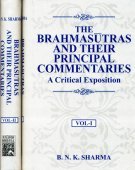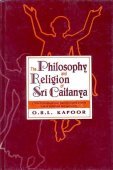Ramanuja, Rāmānuja, Rama-anuja: 14 definitions
Introduction:
Ramanuja means something in Hinduism, Sanskrit, Marathi. If you want to know the exact meaning, history, etymology or English translation of this term then check out the descriptions on this page. Add your comment or reference to a book if you want to contribute to this summary article.
In Hinduism
General definition (in Hinduism)
Source: WikiPedia: HinduismRamanuja (traditionally, 1017–1137 CE) was a Hindu theologian, philosopher, and scriptural exegete, born in a Tamil Brahmin family in the village of Sriperumbudur, Tamil Nadu. He is also known as Sri Ramanujacharya, Udayavar, Ethirajar (Yatiraja), Emberumannar and Lakshmana Muni. He is seen by Sri Vaishnavism as the most important Acharya (teacher) of their tradition who followed Nathamuni and Yamunacharya, and by Hindus in general as the leading expounder of Vishishtadvaita, one of the classical interpretations of the dominant Vedanta school of Vedic philosophy.
Swami Ramanuja incorporated teachings from 5 different people who he considered to be his Acharyas
- Peria Nambigal (Mahapurna),
- Thirukkotiyur Nambigal (Ghoshtipurna),
- Periya Thirumalai Nambigal (Shailapurna),
- Tirumālai Aandaan (Maladhara),
- Azhwar Thiruvaranga Perumal Arayar (Vararanga).
Rāmānuja (c. 1077-1157 CE) continued in the Vedānta tradition of Śaṅkara, which took its inspiration from the Upaniṣads. Both agree that reality is ultimately a single divine entity. But where Śaṅkara took the appearances around us as illusionary appearances of the real oneness, Rāmānuja argued they were real - parts of the ultimate oneness. He tied this oneness to a personal God, Lord Viṣṇu.
Source: Oxford Bibliographies: HinduismRāmānuja (traditional dates b. 1011–d. 1137 CE) is a Tamil Brahmin and a major figure both in the development of Hindu theism and of the Vedānta tradition of religious philosophy. [...] Rāmānuja is revered as its principal teacher (ācārya) by the south Indian Śrī Vaiṣṇava tradition, centered on the worship of the male deity Viṣṇu in the form of Nārāyaṇa together with his consort, Śrī. Śrī Vaiṣṇavism developed as a form of devotional theism (bhakti) based on the Tamil hymns of the poet saints, the Āḻvārs (6th–9th centuries CE), while also drawing on the Pāñcarātra tradition of theistic doctrine and ritual. Writing in Sanskrit, Rāmānuja’s greatest achievement was to develop a realist and theist interpretation of the Vedānta.
Source: Yoga Studies: HinduismRāmānuja, was a disciple of Śrī Yāmunācarya. Śrī Yāmunācarya, composer of texts such as the Gītārtha Saṃgraha, Siddhi Traya and Stotra Ratna, was the grandson of the 9th century sage Śrī Nāthamuni and a forebear of T Krishnamacharya. Krishnamacharya’s personal devotional philosophy and practices were grounded in the teachings that arose from these great sages and evolved into what became known as Viśiṣṭādvaita or qualified non-dualism (One of the three primary schools of Vedānta).
Source: Forgotten Books: Hindu ReligionsRamanuja—According to the Bhargava Upapurana (bhārgavopapurāṇa), Ramanuja is said to have been an incarnation of the serpent Shesha (śeṣa), whilst his chief companions and disciples were the embodied Discus, Mace, Lotus, and other insignia of Vishnu (viṣṇu).
Kanara account of his life, called the Divya Charitra, he is said to have been the son of Sri Keshub Acharya and Bhumi Devi; and, as before, an incarnation of Shesha (śeṣa). He was born at Perumbur, and studied at Kanchi, or Conjeveram, where also he taught his system of the Vaishnava faith. He afterwards resided at Sri Ranga, worshipping Vishnu as Sri Ranga Nath, and there composed his principal works, he then visited various parts of India, disputing with the professors of different creeds, overcoming them of course and reclaiming various shrines, then in possession of the Saivas for the worshippers of Vishnu, particularly the celebrated temple of Tripeti.
Languages of India and abroad
Marathi-English dictionary
Source: DDSA: The Molesworth Marathi and English Dictionaryrāmānuja (रामानुज).—m (S The younger brother of Rama.) A sect or distinction among the worshipers of Vishn̤u.
Source: DDSA: The Aryabhusan school dictionary, Marathi-Englishrāmānuja (रामानुज).—m A sect or distinction among the worshippers of viṣṇu.
Marathi is an Indo-European language having over 70 million native speakers people in (predominantly) Maharashtra India. Marathi, like many other Indo-Aryan languages, evolved from early forms of Prakrit, which itself is a subset of Sanskrit, one of the most ancient languages of the world.
Sanskrit dictionary
Source: DDSA: The practical Sanskrit-English dictionaryRāmānuja (रामानुज).—Name of a celebrated reformer, founder of a Vedāntic sect and author of several works. He was a Vaiṣṇava.
Derivable forms: rāmānujaḥ (रामानुजः).
Rāmānuja is a Sanskrit compound consisting of the terms rāma and anuja (अनुज).
Source: Cologne Digital Sanskrit Dictionaries: Shabda-Sagara Sanskrit-English DictionaryRāmānuja (रामानुज).—m.
(-jaḥ) Name of the founder of a Vedantic sect.
Source: Cologne Digital Sanskrit Dictionaries: Aufrecht Catalogus Catalogorum1) Rāmānuja (रामानुज) as mentioned in Aufrecht’s Catalogus Catalogorum:—with the title yatirāja According to the Prapannāmṛta he was a son of Nṛsiṃhācārya of the Kuśikagotra, or of Keśava of the Hārītagotra, who lived at Bhūtapurī in Toṇḍīramaṇḍala. The same authority states that, towards the end of his life, he founded in 1091 an image of Nārāyaṇa on Yādavācala. L. 1731: Aṣṭādaśarahasyāni. Īśāvāsyopaniṣadbhāṣya. Kaṇṭakoddhāra. A deficient title. Kūṭasaṃdoha. Gadya and Gadyatraya. Guṇaratnakośa. Cakrollāsa. Divyasūriprabhāvadīpikā (?). Devatāpāramya. Deha (?). Nāyakaratna Nyāyaratnamālāṭīkā. Nārāyaṇamantrārtha. Nityapaddhati. Nityārādhanavidhi. Nyāyapariśuddhi. Nyāyasiddhāñjana. Pañcapaṭala. Pañcarātrarakṣā. Praśnopaniṣadvyākhyā. Bhagavadgītābhāṣya. Maṇidarpaṇa. Matimānuṣa (?). Muṇḍakopaniṣadvyākhyā. Yogasūtrabhāṣya. Ratnapradīpa. Rāmapaṭala. Rāmapaddhati. Rāmapūjāpaddhati. Rāmamantrapaddhati. Rāmarahasya. Rāmāyaṇavyākhyā (?). Rāmārcāpaddhati. See Rāmapūjāpaddhati. Vārttāmālā. Viśiṣṭādvaitabhāṣya. Viṣṇuvigrahaśaṃsanastotra. Viṣṇusahasranāmabhāṣya. Vedāntatattvasāra. Vedāntadīpa. Vedāntasāra. Vedārthasaṃgraha. Vaikuṇṭhagadya. Śatadūṣaṇī. Śaraṇāgatigadya. Śrībhāṣya. Śrīraṅgarājastotravyākhyā (?). Śvetāśvataropaniṣadvyākhyā. Saṃkalpasūryodayaṭīkā (?). Saccaritrarakṣā and—[commentary] Saccaritrarakṣāsāradīpikā. Sarvārthasiddhi.
2) Rāmānuja (रामानुज):—Daśopaniṣadvyākhyāna. These are: Īśāvāsya, Kena, Kāṭhaka, Praśna, Muṇḍaka, Māṇḍūkya, Taittirīya, Bṛhadāraṇyaka, Chāndogya, Aitareya. Printed at Madras 1875. Mahābhāratasaṃkṣepaṭīkā or Vyākhyāpradīpa. Mūlamantrārthasāra. Śrīraṅgagadya.
3) Rāmānuja (रामानुज):—Rāmagati Pañcasaṃskārātmikā.
Source: Cologne Digital Sanskrit Dictionaries: Monier-Williams Sanskrit-English Dictionary1) Rāmānuja (रामानुज):—[from rāma] m. ‘younger brother of Rāma’ (this title would be applicable to Kṛṣṇa as born after Bala-rāma of the same father)
2) [v.s. ...] Name of a celebrated Vaiṣṇava reformer (founder of a particular Vedantic school which taught the doctrine of viśiṣṭādvaita or qualified non-duality id est. that the human spirit is separate and different from the one Supreme Spirit though dependent on it and ultimately to be united with it; he lived at Kāñcīpuram and Śrī-raṅgam in the South of India, in the 12th century, and is believed by his followers to have been an incarnation of Śeṣa; he is also called Rāmānujācārya and Yati-rāja; n. or jam matam, Rāmānuja’s doctrine), [Religious Thought and Life in India 119, 448 etc.]
3) [v.s. ...] (with dīkṣita) Name of another author, [Catalogue(s)]
[Sanskrit to German]
Sanskrit, also spelled संस्कृतम् (saṃskṛtam), is an ancient language of India commonly seen as the grandmother of the Indo-European language family (even English!). Closely allied with Prakrit and Pali, Sanskrit is more exhaustive in both grammar and terms and has the most extensive collection of literature in the world, greatly surpassing its sister-languages Greek and Latin.
Kannada-English dictionary
Source: Alar: Kannada-English corpusRāmānuja (ರಾಮಾನುಜ):—
1) [noun] any of the three brothers of Rāma [but applicable esp. to Lakṣmaṇa].
2) [noun] a great sage-philosopher (1027-1137) who founded the school of Viśiṣṭādvaita, which propounds that the individual soul emerges from the Supreme Being and is eternal and the same as Supreme Being in essence, but retains its self-consciousness and separateness while enjoying a close communion with the Supreme Being.
3) [noun] a follower of this philosophy.
Kannada is a Dravidian language (as opposed to the Indo-European language family) mainly spoken in the southwestern region of India.
See also (Relevant definitions)
Starts with (+13): Ramanuja dikshita, Ramanuja yatiraja, Ramanuja-kuta, Ramanujabhashyagambhirya, Ramanujacampu, Ramanujacarita, Ramanujacaritra, Ramanujacarya, Ramanujadandaka, Ramanujadarshana, Ramanujadasa, Ramanujadivyacaritra, Ramanujagrantha, Ramanujaguruparampara, Ramanujamatadhvamsana, Ramanujamatakhandana, Ramanujamauktika, Ramanujanityakarmapaddhati, Ramanujaradhanavidhi, Ramanujashatakatika.
Ends with: Krishnaramanuja, Rangaramanuja, Suramanuja.
Full-text (+310): Ramarcapaddhati, Shribhashya, Purvacaryavrittantadipika, Prapannamrita, Vedarthasamgraha, Sharirakanyayasamgraha, Vicittattuvitam, Ramanujacarya, Vicishtattuvaitam, Vishishta Advaita, Ramanujadandaka, Ramanujavamshavali, Ramanujagrantha, Ramanujavijaya, Ramanujaguruparampara, Ramanujadivyacaritra, Ramanujasiddhantapadavi, Ramanujasiddhantavijaya, Ramanujacarita, Ramanujacampu.
Relevant text
Search found 79 books and stories containing Ramanuja, Rāmānuja, Rama-anuja, Rāma-anuja; (plurals include: Ramanujas, Rāmānujas, anujas). You can also click to the full overview containing English textual excerpts. Below are direct links for the most relevant articles:
Mandukya Upanishad (Madhva commentary) (by Srisa Chandra Vasu)
A History of Indian Philosophy Volume 4 (by Surendranath Dasgupta)
Part 5 - Rāmānuja and Madhva < [Chapter XXV - Madhva and his School]
Part 1 - Vallabha’s Interpretation of the Brahma-sūtra < [Chapter XXXI - The Philosophy of Vallabha]
Part 1 - The Bhāgavata-purāṇa (introduction) < [Chapter XXIV - The Bhāgavata-purāṇa]
Ramanuja’s Interpretation of the Bhagavad-gita (by Abani Sonowal)
Brahma Sutras (Shankaracharya) (by George Thibaut)
Fourth Adhyāya < [Introduction]
Second Adhyāya < [Introduction]
A History of Indian Philosophy Volume 3 (by Surendranath Dasgupta)
Part 2 - Rāmānuja < [Chapter XVIII - An Historical and Literary Survey of the Viśiṣṭādvaita School of Thought]
Part 11 - Veṅkaṭanātha’s treatment of Inference < [Chapter XX - Philosophy of the Rāmānuja School of Thought]
Part 3 - The Precursors of the Viśiṣṭādvaita Philosophy < [Chapter XVIII - An Historical and Literary Survey of the Viśiṣṭādvaita School of Thought]
The Sarva-Darsana-Samgraha (by E. B. Cowell)
Related products

